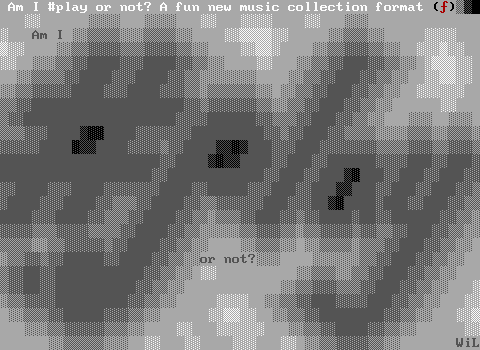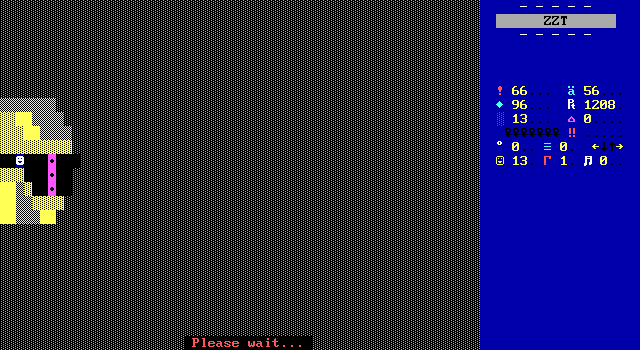Unconventional Strategies
While puzzles generally fall under a few well-defined types, conventional action boards offer too many possibilities to really try and label them. The art of a good action board is therefore a lot harder to define thanks to the sheer number of variables at play. Holub is able to take a lot of less frequently used elements and create some rather varied boards that are even more impressive given the game's age.
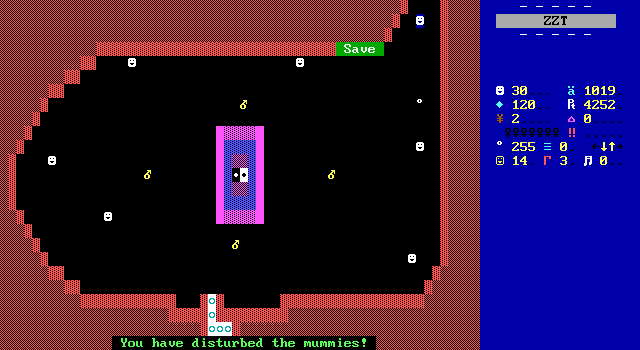
Sure, it's not all wildly original. An early action sequence versus mummies that must be destroyed to continue requires using a limited number of bombs to do so. It certainly calls back to Town of ZZT, with its fight against six dragons in the castle. Holub takes inspiration, but does more than merely copying and pasting the fight. The bombs are in much shorter supply with just four for six opponents, requiring some careful positioning to be able to catch more than one in an explosion.
The mummies themselves are also far more threatening. The dragons in Town were slow and not too focused on actually going after the player. These mummies move faster, and purely chase the player, shooting if they're aligned. This helps group them together, but boy is it easy to light a bomb and then watch as all the mummies get out of the explosion radius when you move to avoid a bullet.
The Lost Pyramid generally does better than this, but this still isn't bad. You can try and pin some of the mummies against the wall in the middle to increase your odds, and once you get one good explosion in, you can be a lot more flexible with the rest.
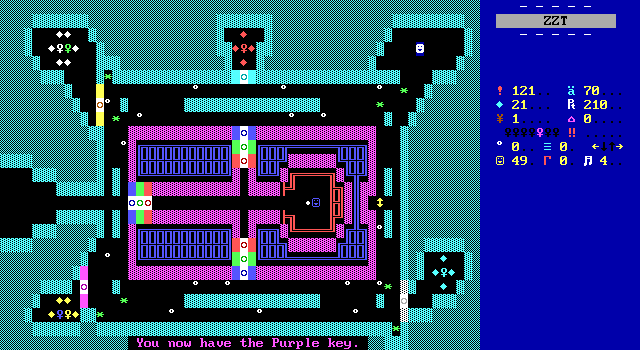
A better example of action done right, even if it too has official ZZT world origins with City of ZZT, is the oracle's chamber. It's simplified in way that picks up the pace and plays better. Rather than a lengthy an unpredictable stream of bullets along a winding ricochet path shot by a spinning gun, an object endlessly alternates between shooting bullets clockwise on the inner path and counter-clockwise on the outer. The player gets to test their speed more than anything you can be locked onto a certain track for a little bit as you make your way around the room to collect keys to open the path to the oracle. It looks colorful with the rainbow door trim (also a plus for legibility!), and plays great. I think this was the moment when I realized this was going to be an adventure worth my time.
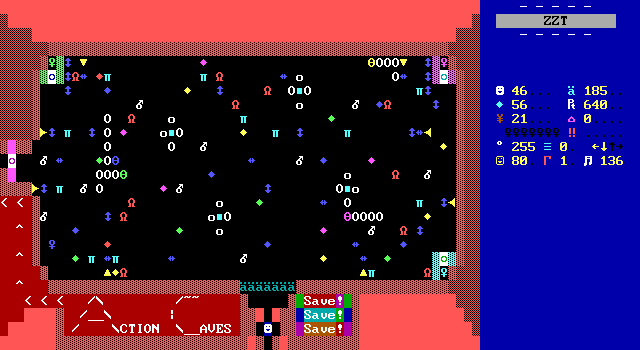
Upon crossing the Zakian gate, the protagonist finds themselves in the "Action Caves". Things definitely sound more like an amusement park than an ancient pyramid at this point, but despite the pivot in tone (regardless of whether or not I'm imagining it), Holub continues his success with some very unique feeling boards that once again mostly get it right.
It looks chaotic and messy, but not overwhelming. The enemies inside are finite with the duplicators adding boulders to obstruct the player's path as they run around the room collecting keys to open doors so they can get more keys until they open the exit. The concept is certainly there, but in practice this one ends up as one of the weaker of these boards. Holub's intentions for the board don't manage to match up with the likely experience of playing it.
The issue comes down to the boulders. A few of the pushers point in their direction and I suspect the intent is that the player can use them to slow down the amount of garbage blocks produced that get in the way of your bullets. There just aren't enough pushers (and sliders) to actually stop the flow, and even if there were, because these boulders are surrounded on four sides, it would be a lengthy process to actually block them all off rather than just opting to go for the keys and ignore them entirely.
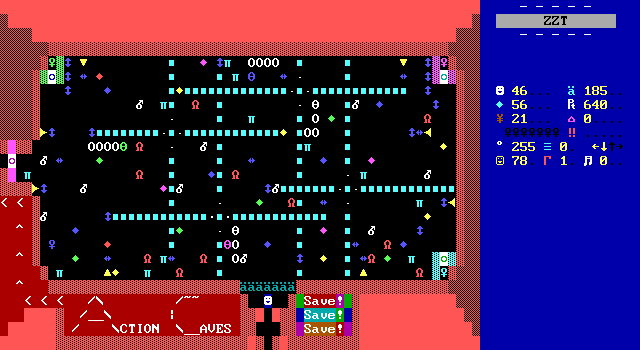
They also duplicate pretty quickly, and if the player recognizes the fact that they're not in danger at all on the board until they collect the ammo, they can then just wait for a little bit and let the boulders actually fill up the room which ends up breaking the board up into several easy pieces. With the board divided like this the player is free to clear out enemies one section at a time with no fear of being ambushed from another direction.
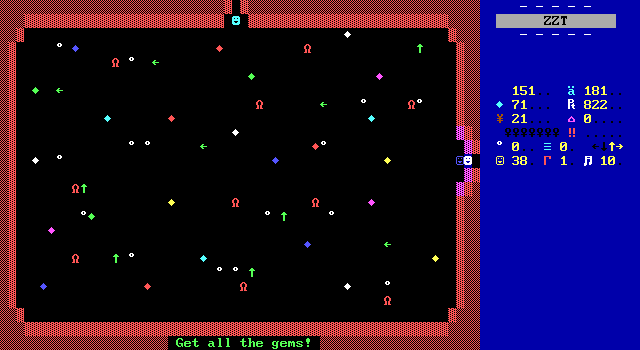
The next board feels like Holub is going for something very similar to the previous, except this time it works just fine.
Now the player has to deal with a few lions and spinning guns while collecting all the gems. Here though, the chaos can't be contained. The player is restricted from shooting on this board and re-enter when zapped is turned out, which results in a very tense experience trying to slip through gaps in the guns' bullets (which honestly, could stand to have their firing rate reduced a little) and not being caught by a lion while waiting for a chance to bolt.
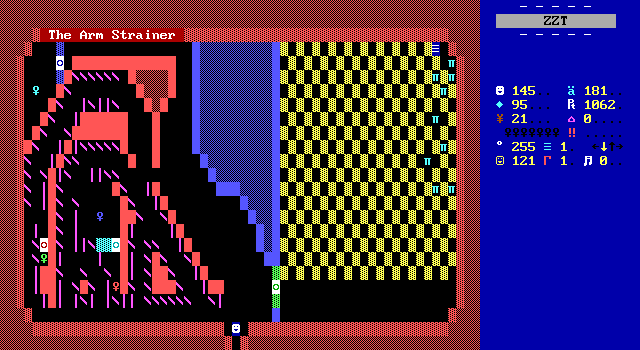
I'm still not sure what to make of this one. "The Arm Strainer" is the most apt name by far, asking the player to make some very tricky movements through a series of conveyors to get keys. I didn't like playing this as after a certain point as the repeated trips get more and more annoying with each failed attempt requiring you to run back to the entrance of the device. Even so, there was an element of humor to it thank to the name acknowledging the frustrations. Maybe cut back on a key to shorten it a little?
The reward is an equally unexciting fake wall maze with a few tigers in it. Tigers are a nasty choice for an enemy in here as it's very easy to be shot and not know what direction it came from with how quickly the bullets will reach you at close range. There's also a minor issue here where because of how long you'll be in the left half of the board, the tigers will end up funneling to a spot in the maze where they're unable to move south or west towards the player leaving them clumped up in one spot. This could have been avoided pretty easily by surrounding the tigers with objects where there were fake walls, only becoming fakes and allowing the tigers to move once the green door was opened.
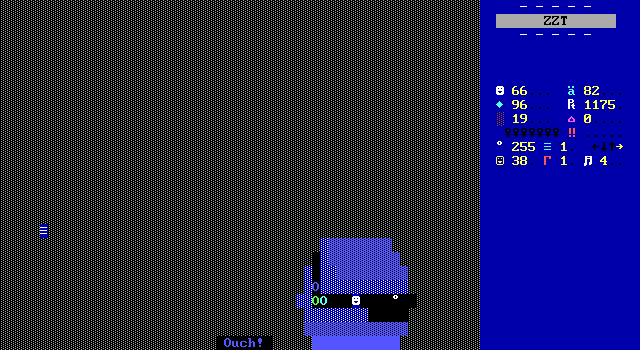
Without dwelling too much on every single board. I was also pleasantly surprised by this dark portion of the caves with a simple maze lined with (cooler) water, and populated with centipedes and tigers. This turns out to be an excellent combination! The limited vision means the player will have to react to the tigers shooting over the water, but be deterred from firing back lest a centipede get in the way and split in two. At the same time, seeing a centipede on the other side of the water means a safer trip since the tiger's bullets will harmlessly destroyed when they hit a centipede. Of course, if you happen to run into a centipede directly, you're going to have to blast them before they attack and that means losing a shield that potentially could be helpful later. What seems like a simple assortment of built-ins ends up being surprisingly intricate here!
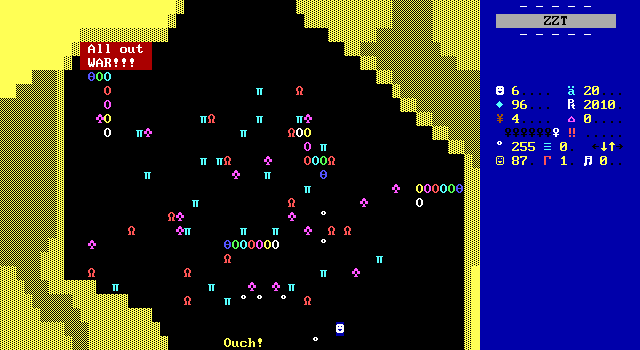
"All out WAR!!!" is another action board that demonstrates how effective a little bit of text can be. This board is nothing more than a scattering of a huge number of creatures that the player needs to blast through, but so late into the game that you can see my health was critical and my ammo fairly dire. In most cases, I don't think a board like this would work very well, but just having that sign is enough to make the pile of monsters go from "Oh Holub is running out of ideas" to "Oh Holub knows this is an intense challenge". In such a state it would be easy to just cheat and move on, but I found myself compelled to keep trying to break through. This mostly requires peeking onto the board from a corner and luring monsters in one direction, then switching to the previous board and entering the warzone from the opposite side.
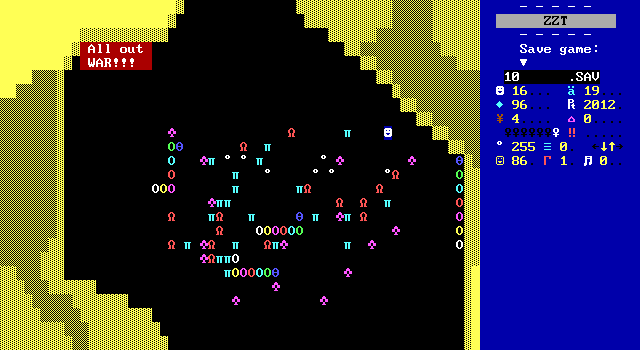
It took some doing, but I actually got through unscathed and was able to go on to reach the idol of Hussafuss unharmed!
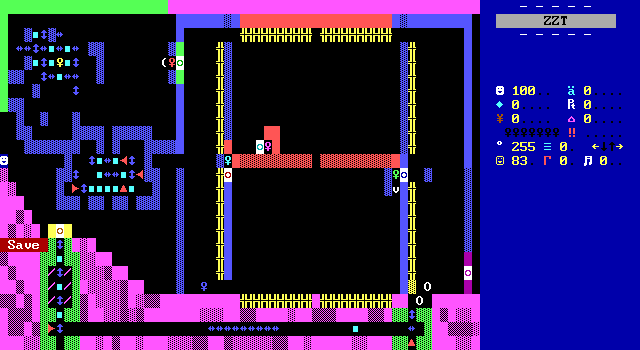
Part puzzle, part action, this board on the eastern path stood out due its excellent use of blink walls. Once more the player needs to get some keys to reach an exit, but the pattern of the blink walls looks very striking, making this board one to gawk at momentarily.
This one is also notable is having some smaller more traditional slider puzzles in order to reach the yellow key as well as to be able to get out of that section of the board after collecting the red key. Impressive from start to finish! And I like that when the board is solved you get to rely on a series of duplicators to get vertical sliders in the proper position to block off the last set of blink walls.
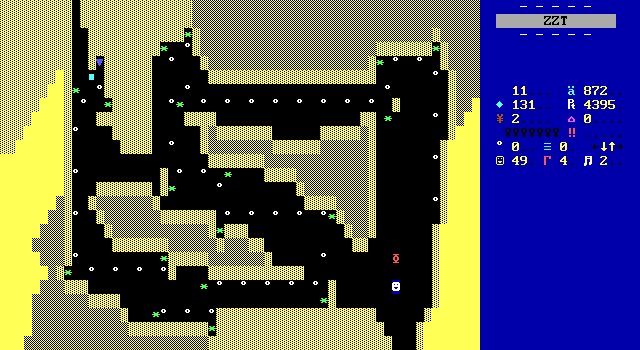
A bit like the gem collecting board in the Action Caves, this board also relies on getting the player to carefully cross a stream of bullets repeatedly. Weirdly, the scroll suggests that the player should save before trying to cross so they aren't warped back to the start of the board. I feel like telling the player to do so makes the whole board feel moot. Why not remove the re-enter when zapped flag and just let the player decide if they'd rather lose health or time? Making them start over when hit makes the board nothing more than a time sink as saving constantly becomes the sensible thing to do. Maybe add some extra bonus treasures to collect for players that are daring?
The Pyramid's Curse
The Lost Pyramid is definitely a game worthy of praise that really holds up quite well three decades later. It boasts a large variety of puzzles and action boards. It avoids so many potential pitfalls that plague early ZZT worlds like a lack of resources or boring board designs. The game looks great, plays great, is of reasonable length for each path, and of course the alternate path is a great reason to go back to the game a second time.
Still, there are a few issues that keep it from perfection. Let me make it clear that Holub's work here is superb overall. This is easily a new favorite of mine, and one that I absolutely recommend anybody that enjoys ZZT games to play for themselves. I just wish it had a few tweaks here and there.
I've already gotten into some of it earlier. A few puzzles puzzles don't work out how Holub intended, and the wildly inappropriate "Crosseye" red herring is just baffling. The secret entrance to the Zakian gate and to the Well of Souls puzzle are some pretty big asks for the player that I think do more harm than good to the experience. Beyond that, there are still a few moments with nitpicking.

Back in the Action Caves I talked about the first board not going according to Holub's plan with patience paying off on a board meant to be frantic. It also suffers from a far more severe issue, which is that it's very easy to crash ZZT on this board. Maybe that's why this board has so many notices to save, since that kind of design is very rarely seen in places outside of puzzles that can't be reset.
The trouble is with the boulders and the duplicators. When ZZT duplicates something on top of the player, it acts as if the player touched the source element instead. This is why it's possible to break duplicators by standing in front of them and grabbing the ammo inside, or tanking a hit from an enemy without having to worry about any more spawning in.
So when a boulder is duplicated onto the player, the boulder acts as if the player touched it. This seems fine. Boulders are shoved around by the player constantly. The trouble is that in this case, the boulder tries to figure out which direction it was pushed and determines it was pushed in no direction at all, so a vector of (0, 0). And so it looks at what element is (0, 0) tiles away from the boulder to determine if the push can be performed and it finds a boulder (itself), meaning it needs to keep checking if that boulder can be pushed. And so it looks at what element is (0, 0) tiles away from the boulder to determine if the push can be performed and it finds a boulder (itself), meaning it needs to keep checking if that boulder can be pushed. And so it looks at what element is (0, 0) tiles away from the boulder to determine if the push can be performed and it finds a boulder (itself), meaning it needs to keep checking if that boulder can be pushed. And so it looks at what element is (0, 0) tiles away from the boulder to determine if the push can be performed and it finds a boulder (itself), meaning it needs to keep checking if that boulder can be pushed...
Needless to say this infinite recursion crashes ZZT.
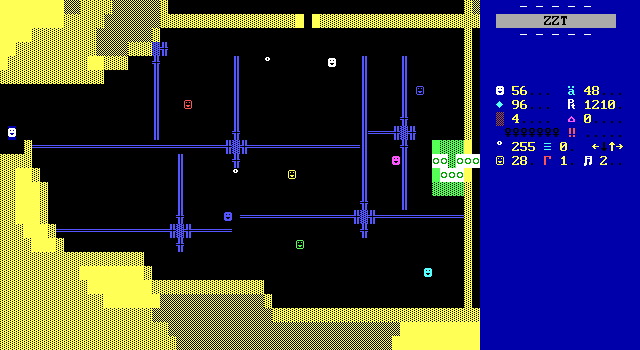
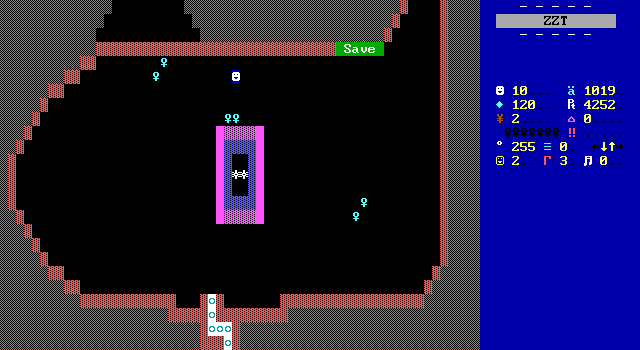
Both this... weird board against "dudes" as the objects are named and the mummy board have objects that drop keys when defeated. On both boards, the keys dropped are all the same color, and since you can only carry one of each key color at a time, that means a lot of running around grabbing the keys. On the board with the dudes, it's not as bad, as there's still the threat of blink walls so having to run around a bit more is somewhat engaging. For the mummy board once the mummies are destroyed it's just tedious to pick them all up.
Both of these boards would do better with just having an object open a gate or something when all the enemies were defeated rather than using ZZT's keys and doors. Also since the dudes take a lot of shots but use #BIND to share code, all the dudes after the first one is destroyed will be destroyed in one shot. It's a bug that improves the fight by speeding things up. The dudes are not particularly exciting to fight.

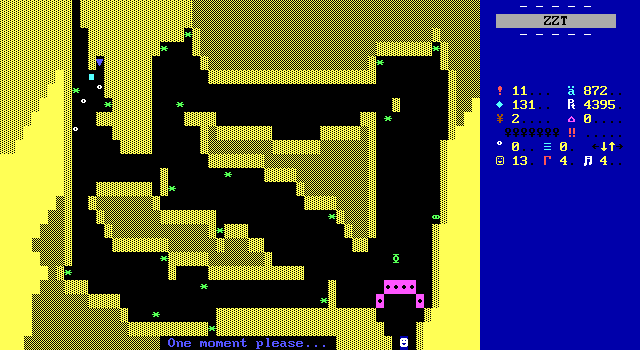
This is also a ZZT game that has loading times?
Proc gen this ain't, so having to actually wait before you can play two of the game's boards is pretty absurd.
For the first of these boards, the red objects slowly fan out before moving in a rectangle along the walls, regularly shooting bullets inward to protect the white key. This could readily have been fixed by just actually using four identical objects and having each one jump to a label at each corner. Instead #BIND is used again with some idles to properly space them apart which results in having to stop the gameplay entirely in a dark room. I had no idea why this board had a pause like this when I was finally let loose inside.
The second one is a little more understandable. The lights are on so it's also clear why you have to wait: to let the object populate the stream of bullets you need to cross. The ∞ object is used to open the door once it's been shot. In 1992 this is a tougher problem to fix as ZZT's editor won't let you just place bullets down the way modern editors do. One fix would have been to import the board onto a title screen in a new world, let it run until it was ready, then open the editor where the game's current state would be preserved, and then export the board. That's probably some pretty esoteric knowledge in 1992 though so I can't be too upset with Holub for having the wait here.
It breaks the pacing to be sure, but it is kind of fun to watch.
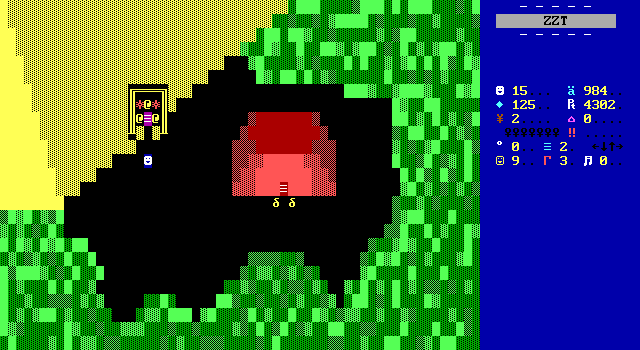
On the eastern path, quite early on, you go outside of the pyramid and into a separate tomb. This game doesn't need more stereotypical "natives", but it sure could use something to justify why the tourist you're playing as is unable to just run off from here!
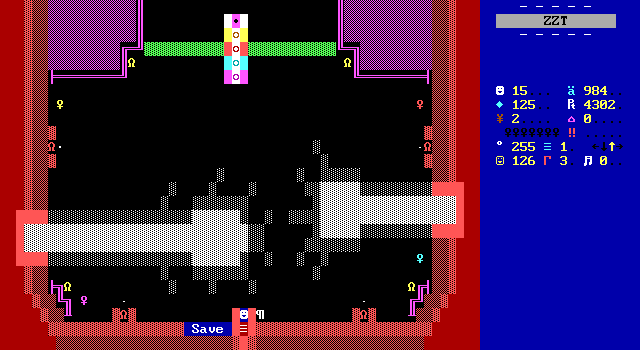
This seemingly innocuous board is one of the game's most dastardly, and entirely for reasons unintended.
It's yet another key collecting room with lions that get duplicated in from four regions of the board. The problem here is in the beams of light that shine into the room. Some hieroglyphs earlier warn the player to stay out of the light, and sure enough if the player attempts to stand on these tiles the yellow lion statues activate, instantly flooding the room with an excessive amount of stars.
That's not the issue! I mean, it is an issue, but that's just the trap effectively being the same as an instant game over.
The issue I want to bring up, is that the light that you can step on is made up of well over 100 objects. You can see the stat count of 126 in the screenshot. This is a lot, but in most cases you'd still be able to do an action board without worrying about that limit. Alas, this action board is based on duplicators that produce endless amounts of enemies. They're pretty quick filling and so it doesn't take long before the stat limit is hit, and once that happens the player can no longer fire bullets turning this into an even more difficult version of "All out WAR!!!" with an excessive amount of enemies that this time can't really be killed.
Because the duplicators are also constantly trying and failing to produce more lions at this point, even if you take a few hits to reduce the stat count, it promptly refills. Getting past this board meant actually relying on shooting creatures at point blank range as the check for this happens before the check on whether or not a bullet needs to be spawned, and let me tell you, ZZT is not designed for all shooting to be at point blank range.
The lions intelligence is set high enough though that it's a surprisingly workable tactic and you can get things under control after a bit. Once you can get a few bullets on the board the stat limit is still hit, but it's possible to keep shooting and prevent the lions from immediately being replaced by freshly duplicated ones.
It ends up being a very cruel board in unintended ways.
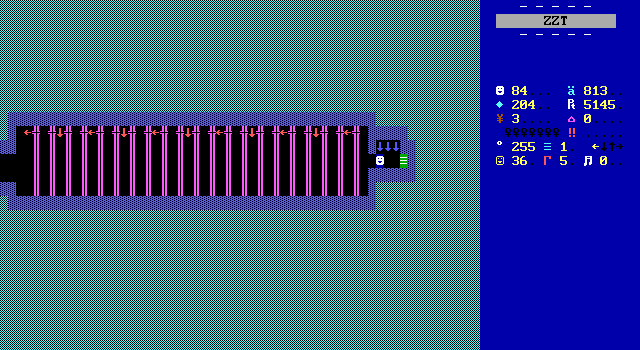
For a game with as much clear effort demonstrated as The Lost Pyramid, this one was quite unexpected. A corridor of blink walls with the safe spots being made dangerous by spinning guns. There's no strategy to this here. Even if you run along the bottom row to have some extra time before a bullet can reach the player, the blink wall rate is too slow and you can still be shot regardless. This board is all about holding right and hoping you don't lose too much health. At the very least, Holub did set the firing rate as low as ZZT permits it, so you might actually fare better pacing yourself and making sure to avoid the blink wall rays at the risk of being shot. Even so, it all comes down to luck in the end.
(Oh, and those blue arrows are objects, not spinning guns. Holub isn't cruel on purpose.)
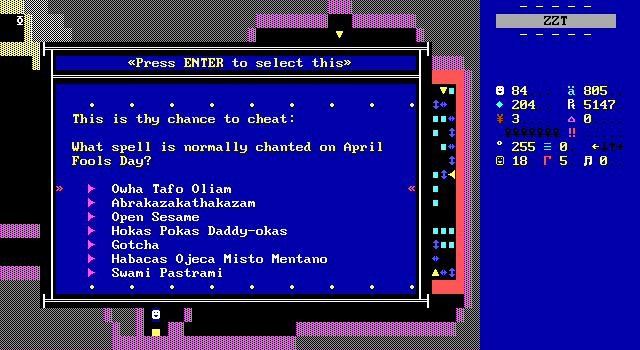
Lastly, we have a quiz. These are something that I believe are never really worth including in a ZZT game. Here the trivia is all over the place, starting with this question whose answer Owha Tafo Oliam turns up no results when searched which is not a good start. Other questions ask about "Famous Amos" brand foods, to some common riddles.
Incorrect answers don't hurt the player, or end the game, but take the worst option of all: locking the object. This forces the player to quit out of the game and reload the long way. The wording about "thy chance to cheat" made me assume that this was going to be a source of bonus points or supplies, akin to the trivia in Super ZZT's Monster Zoo. Were that the case, it would feel out of place, but not be such a big deal. Instead, this is a subpar puzzle to obtain a mandatory key.
Polished Effects
One aspect of the game that caught me of guard was just how much care had been put into the visual presentation throughout the game. A lot of the boards look nice in still images, yet there's a lot more going on during gameplay as well as unexpected detail work that really make this a standout title for 1992.
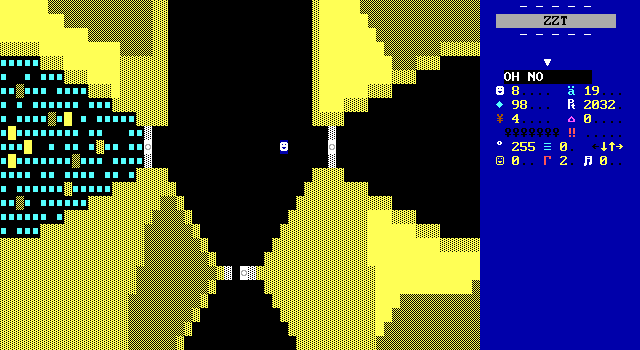
I had mentioned previously how the game introduces the idea that there are three paths to the idol with one rendered inaccessible due to collapsed tunnels. At first this seems like a quite little joke where the one easy path is the one that happened to become blocked off. Holub kept that detail in the back of his mind though. Here, just prior to reaching the idol of Hussafuss where the two paths meet, there's a third caved-in path as well. This is no mere visual gag. This pyramid is more than just a setting for a game and it has regions that the player will never get to see. The consistency here is to be applauded.
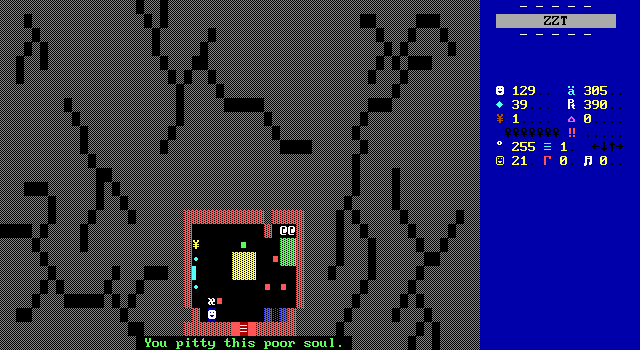
Depending on which path the player ends up on, they'll run into a village at some point. One of which has a trapped party of archaeologists who have given up on escaping the pyramid, the other of which is completely abandoned. It's unclear if there was a second group or if the archaeologists had to abandon this previous village or not. What is clear is that the design of the building interiors are basically identical. However, for the abandoned village home shown here, the interior is filled with rubble and the background has these large cracks to help sell you on the idea that this place has been forgotten. With how common tiny boards like this are set against a plain back background or basic flood-fill, the extra presentation helps this board stand out.
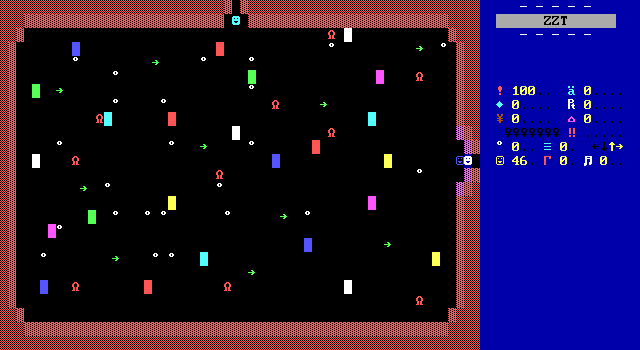
Small bits of extra effort help to up the presentation here in the Action Caves. Acknowledging the very visually busy appearance of the board, starting your efforts to collect all the gems provides a helpful flicker of all of them still on the board. This effect plays again whenever the object blocking the exit is touched with gems still remaining. It's an excellent way of helping the player spot any gems they may have overlooked.
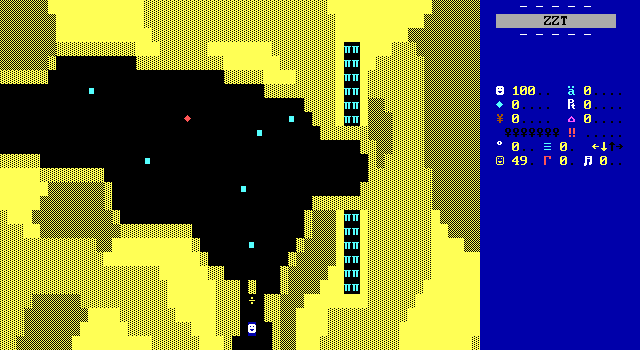
The tiger trap in the maze is another excellent showpiece for the game. Investigating the weird object causes the player to be caught and dragged briskly over to the tigers. Holub impresses yet again by not just releasing the tigers and erasing the objects, but instead turns them into breakables so the player has a moment before the tigers can get to their prey. This gives the player a moment to ready themselves without running the risk of just instantly being barraged by bullets before the player is aware of what happened.
Lastly, spoilers for the ending sequence which at first glance is just flying away in a helicopter. Give this one a quick watch and I bet you'll be surprised. RIP to the group of archaeologists living in the pyramid.
Final Thoughts
Just all around, The Lost Pyramid is a fantastic early adventure game that goes above and beyond the expectations of the era. From beginning to end I was enjoying myself, and no matter what little snafus I'd run into, they were nothing compared to the creativity on display here. Holub made a game that absolutely showcases what can be done with ZZT when focusing on its included elements more than trying to delve into the complexity available via code, resulting in a new favorite.
The puzzles are fun. Resources are tight enough to matter, but not so tight that you'll have to reload a save or cheat to finish a board in good shape. Even the torches for the game's few dark rooms are perfectly rationed. Holub created an adventure here that anyone can enjoy and one that I can't recommend enough.
The game's flaws are nothing for the time, and easily overlooked today. The Lost Pyramid manages to make a maze fun, and it does so in 1992! It's incredible how smoothly this one plays, how it offers such replayability, and how much it seems to want the player to succeed. Holub made some pretty unconventional choices with this one, and while not everything goes according to plan, the experience makes it such a success.
When you collect the idol of Hussafuss, you don't go directly to the ending. You don't find a hidden chute that warps you to the entrance. Holub makes the player walk. You actually have to walk out of the pyramid. I think this is a backtracking record. 27 board transitions gets you to the pyramid entrance board you started on!!!! Yet it doesn't suck because you'll have left just enough monsters and have just so little health that it kind of works? This man turns ZZT garbage into gold, leaving me singing praise to backtracking, mazes, and slider puzzles. It's really astonishing. The Lost Pyramid is a game I already want to play again. There's a surprising amount of beloved titles from 1992 thanks in part to Best of ZZT and ZZT's Revenge along other titles like The Lost Monkeys and Toxic Terminator, but I think The Lost Pyramid may be my new favorite of them all.

